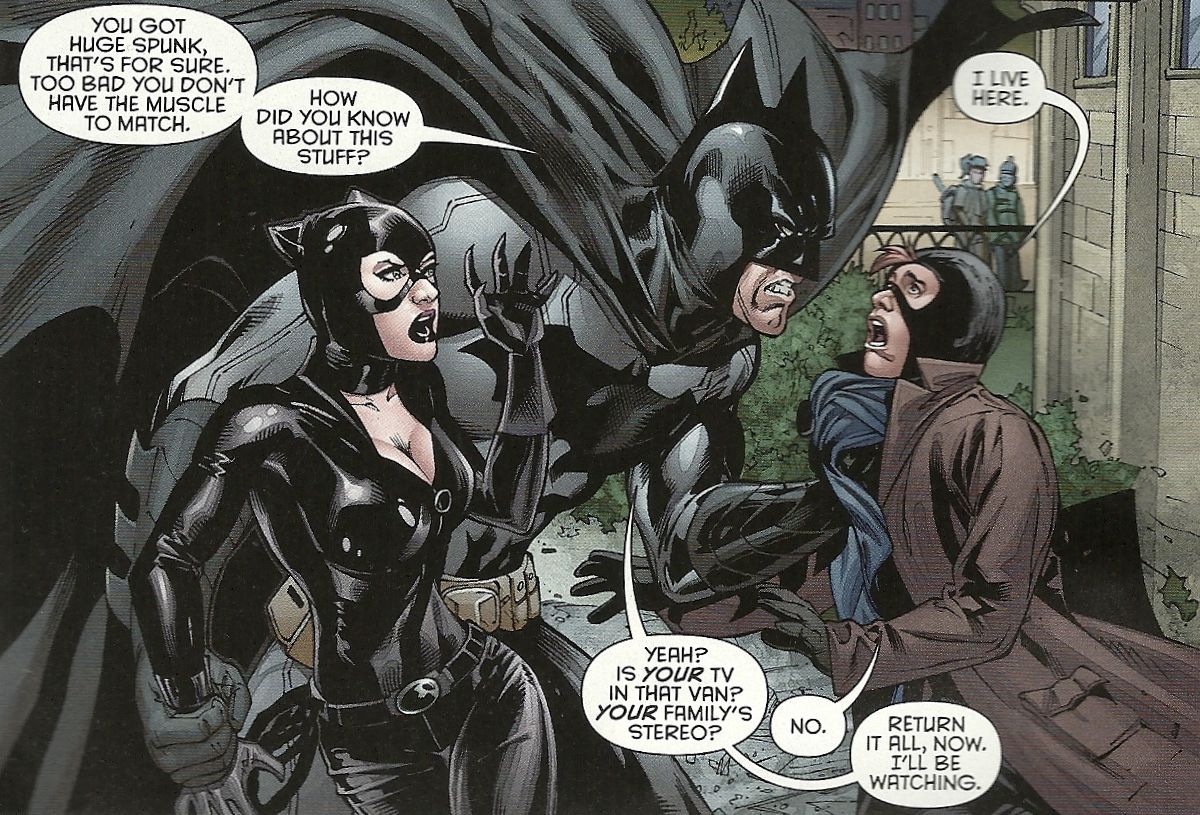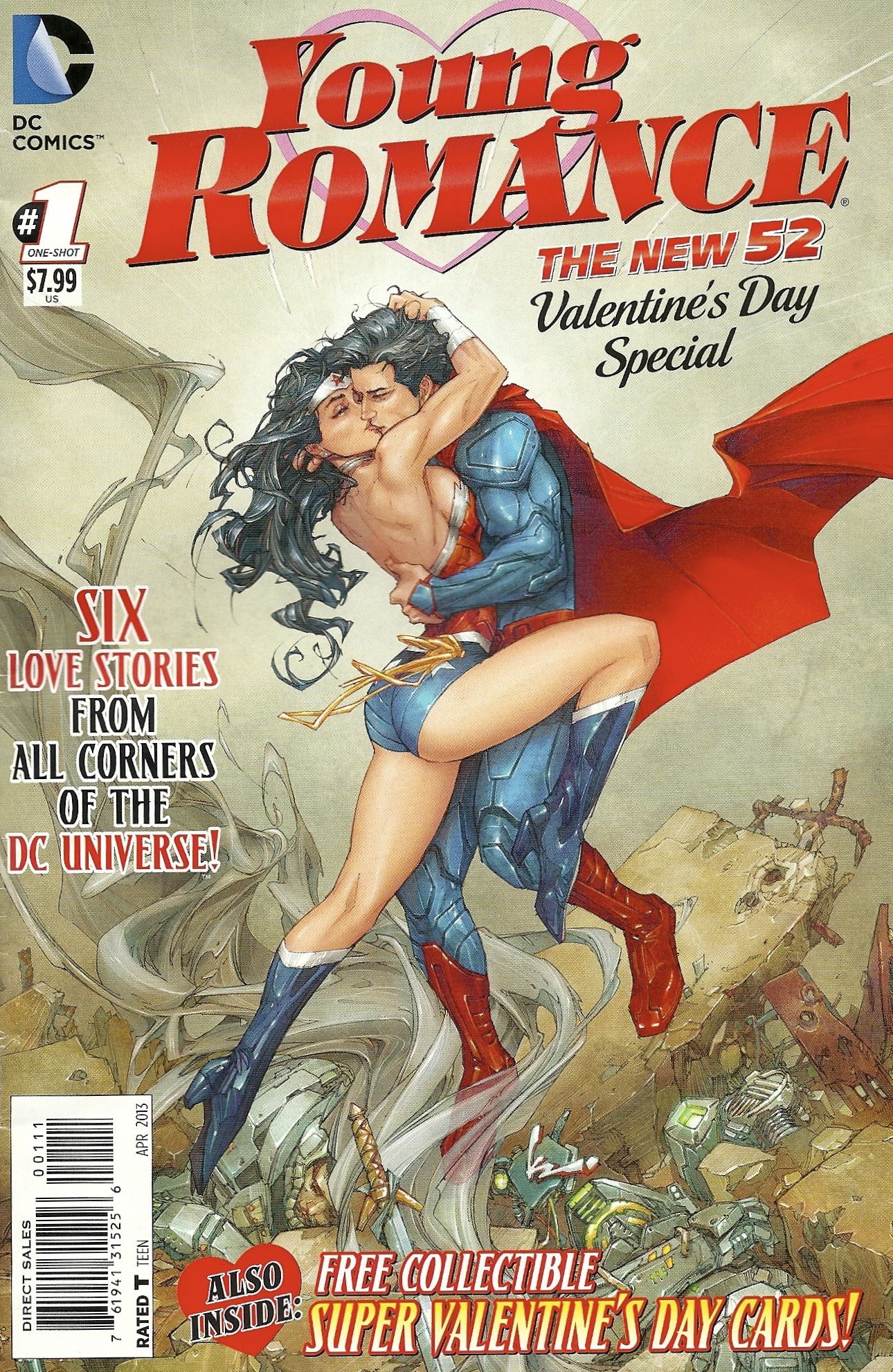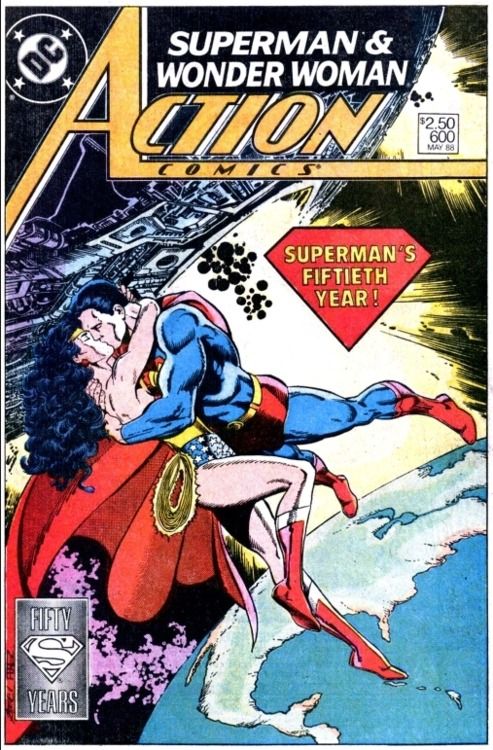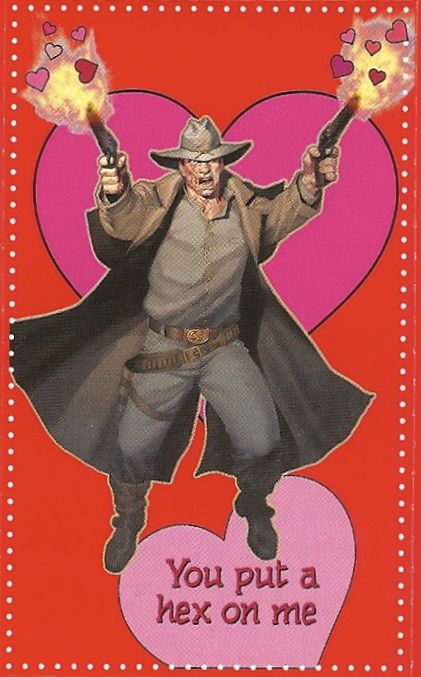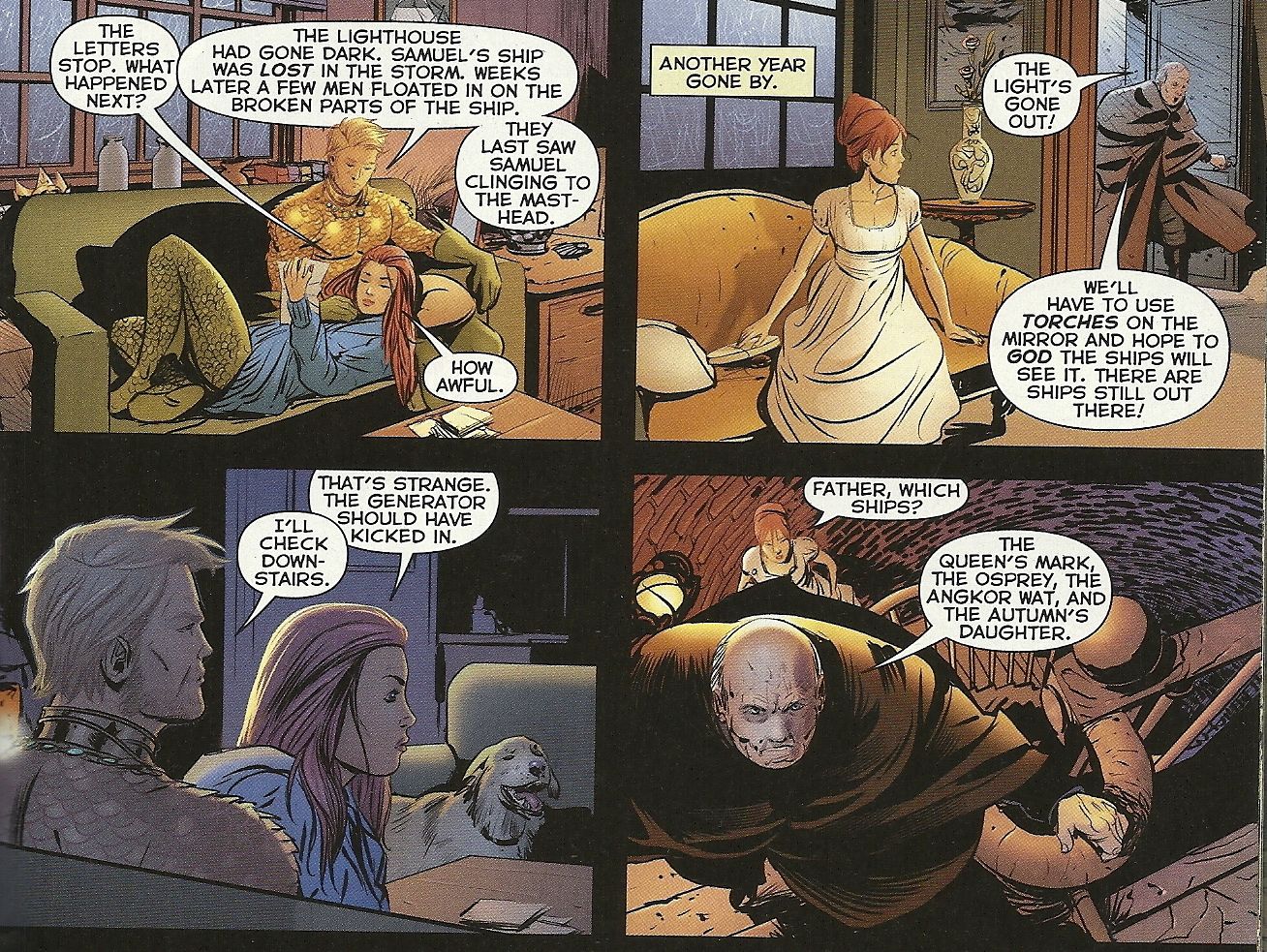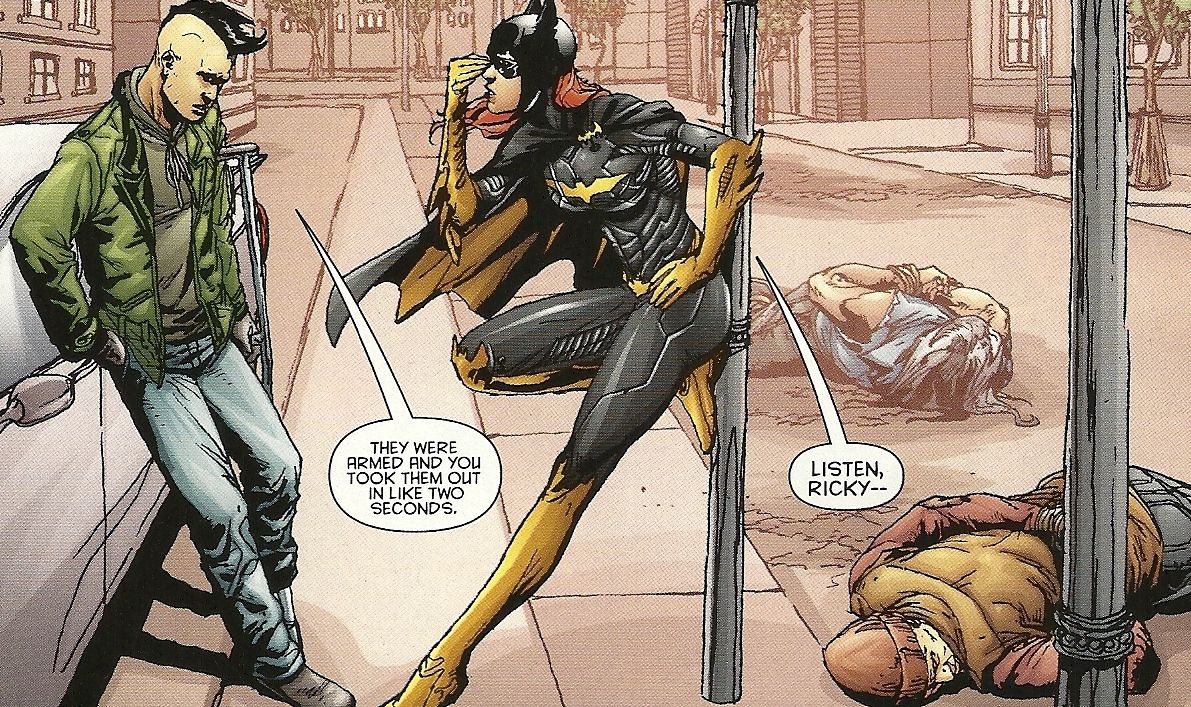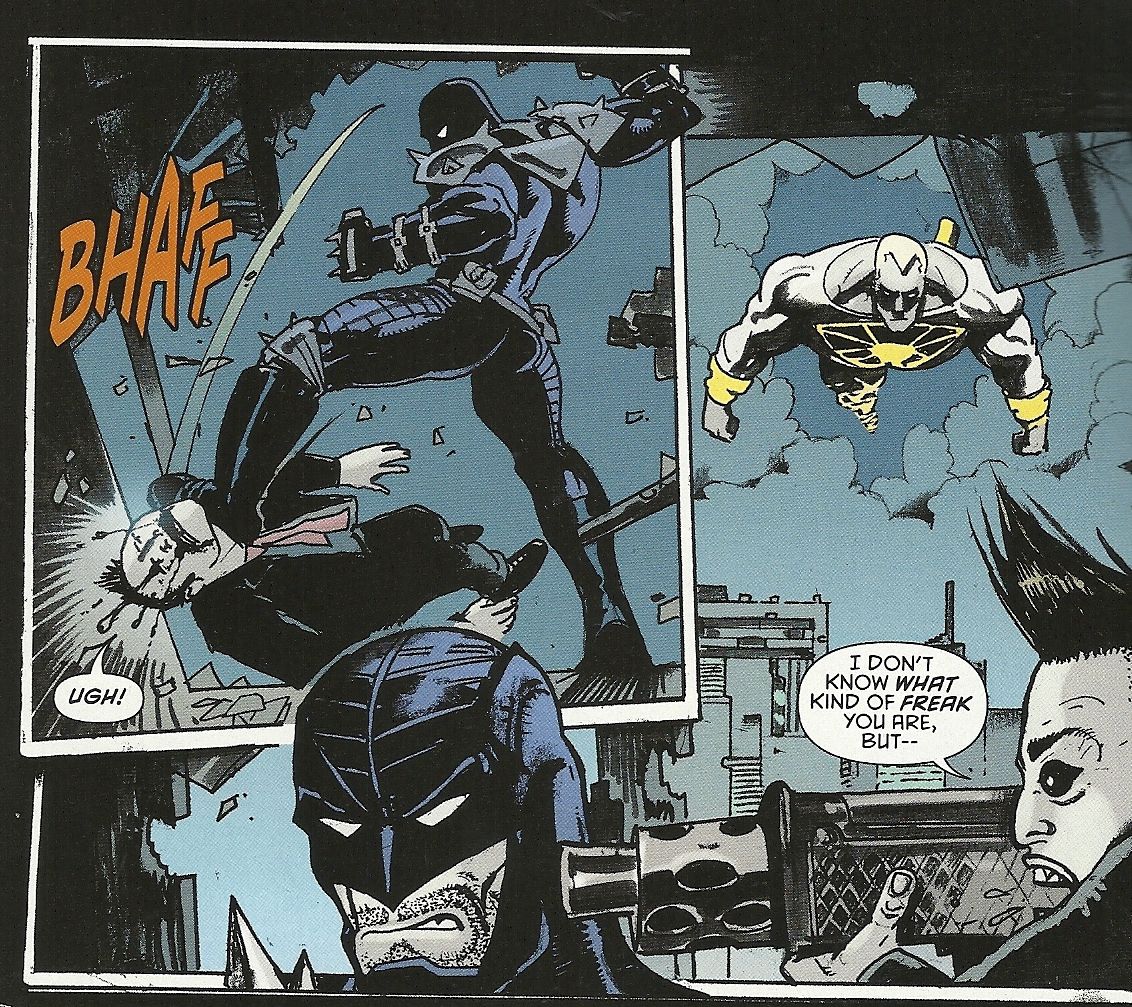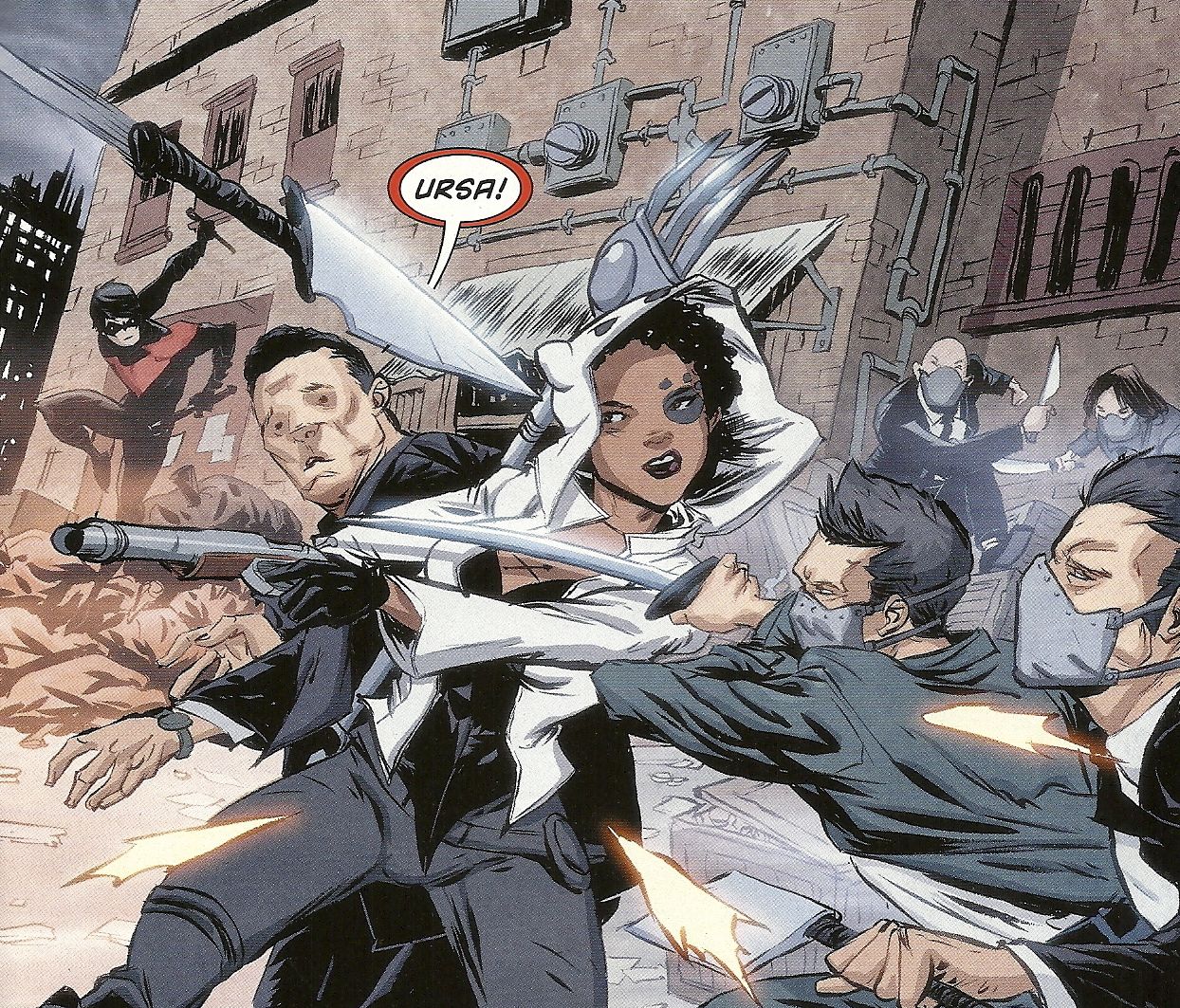Whether due to use-it-or-lose-it legal concerns about trademarks, or simply to remind everyone of exactly what it owns, DC Comics has come up with a variety of ways to recycle old titles, ranging from the 1997 Tangent event to the anthologies Mystery in Space and Ghosts to the short-lived National Comics revival.
This week the company brought back Young Romance, the title of the Joe Simon/Jack Kirby-created comic that was published from 1947 to 1975, as a Valentine's Day special featuring a half-dozen stories of romance in the New 52 DC Universe.
An interesting mix of creators are involved, an interesting enough mix to merit a look at what they might do with some of these characters and couples in eight pages. So join me for mini-reviews of every story in Young Romance: The New 52 Valentine's Day Special.
The cover/etc.
I'm a fan of artist Kenneth Rocafort's work; he has a dynamic, energetic style with enough quirk to call his own, and he has the talent to sell it. That said, his image of Wonder Woman in an off-model costume soaring her pelvis into Superman's above a pile of rubble containing a dude or two who look like they might be related to teammate Cyborg isn't anything to write home about.
Part of that may be because there's already a more striking, graceful and romantic image of these two sharing a kiss, which DC fans of a certain age will no doubt remember.
Wonder Woman's costume is blue and red here instead of the black and red seen in her own title, but I kind of like the way she matches Superman -- it looks like they color-coordinate, like a truly sickeningly sweet couple.
I would have preferred a cover featuring the heroes in the style of a romance comic, a tight close-up of them embracing, or Wonder Woman crying and thought-clouding about how difficult their relationship is, maybe even some Ben-Day dots. Ah, well, maybe next year.
The "From All Corners of the DC Universe!" is kind of funny, given that half of the six stories take place in Gotham City and involve the Bat Family.
Also teased on the cover are the "Free Collectible Super Valentine's Day Cards!" These are 18 little valentines of the sort you used to give and get in grade school, with perforated edges to more easily separate them from your comic. (Buy two! One to save in mint condition, and one to take the valentines out of!) Each has a superhero on it, and a pun-like message like "You're wonder-ful" on the Wonder Woman card, and "I get a side-kick out of you" next to Robin.
The Catwoman one seems purposefully chosen to irritate online fans, as it features the infamous pose from the cover of Catwoman #0.
My favorite is probably the Captain Marv-er, Shazam one, which features that crazy rendition of the character making an expression I can't even begin to guess at from the cover of Justice League #0 (next to the words "Say the magic word and I'm yours" ) and the Jonah Hex one ("You put a hex on me"), where he is either shooting at the little clouds of cartoon hearts floating around or he is shooting clouds of cartoon hearts out of the barrels of his guns — either way, it amuses me.
Batman and Catwoman in "Think It Through" by Ann Nocenti, Emanuela Lupacchino and Jaime Mendoza
The regular Catwoman writer teams with guest artists for Selina's telling of the night she met Batman. Obviously, this version is a lot different than the one you'll find in Batman: Year One.
Selina, wearing her current Catwoman costume with a slightly different mask, and her friend and partner-in-crime Billy, who isn't dressed like a cat or any other kind of animal, are pulling off a rather unambitious heist with innocent targets. Batman swoops in to stop them and give Catwoman what was no doubt the first of many lectures.
It's a decent set-up of their current relationship, and how that first encounter might have informed it. Nocenti's Batman sounds funny to me, using idioms that seem un-Batmanlike, but it was Lupacchino's image of Batman that really stuck with me. Either he's 10 feet tall, or Selina and her pal are 3 feet tall.
It's a decent enough short story, though, and explicitly teases another Batman/Catwoman encounter in a future issue of Catwoman.
Aquaman and Mera in "The Lighthouse" by Cecil Castellucci and Inaki Miranda
The presence of popular young-adult author (and Plain Janes writer) Castellucci was a nice surprise, as was the style and quality of Miranda's art (he's previously drawn Fairest, Fables and Burnout for Vertigo).
The story is a pretty simple one, the sort of light fluff called for in a holiday-themed anthology. The super-couple are battening down the hatches at their lighthouse home in preparation for a hurricane, and Mera discovers a bundle of love letters shared between a star-crossed 19th century couple (whom Miranda draws to resemble Aquaman and Mera, but not so much so as to suggest they're reincarnations as much as an echo).
The parallel elements of the story are a tad forced, but more so by the brevity of the page count than anything else.
Miranda's art is gorgeous: smooth, clean and airy in a way that sets it apart from the line and ink-heavy work of most New 52 artists, and expressive in both the character "acting" and the movement of figures, panels and pages.
His work was a nice reminder of what can be so appealing about anthologies like this: the chance to encounter the work of new artists a reader may not yet be familiar with.
Batgirl in "Dreamer" by Ray Fawkes and Julius Gopez
Ray Fawkes, who was tapped as the fill-in writer on Batgirl during that weird period during which Gail Simone was fired from the title and then rehired, turns in a short story in which Batgirl Barbara Gordon checks in with Ricky, a young criminal trying to turn his life around, confides her insecurities about dating someone (given her crime-fighting lifestyle), and then shares a kiss with him.
The script suggests a rather cute story, but the art drags it down to almost sub-professional levels.
This is the longest time time I've spent with Batgirl's New 52 costume, which is apparently some kind of filigreed exo-skeleton, and it's a pretty wretched design, so full of lines it seems an unnecessary obstacle to ask an artist to deal with, especially when the story around it has some very basic, panel-to-panel continuity problems, like Ricky's mohawk becoming a full head of hair for one panel before becoming a mohawk again (which could be the colorist's fault), or Batgirl's hair disappearing and reappearing a couple times in the course of the story.
Apollo and Midnighter in "Seoul Brothers" by Peter Milligan, Simon Bisley
The former members of WilldStorm's The Authority, now appearing in Stormwatch, are probably the most powerful gay super-powered power couple, and it's nice to see them included here. This is actually my first exposure to them post-reboot, and I was kind of surprised to see they are apparently not officially a couple yet.
Milligan's story finds Apollo journeying to Seoul (hence the title) to see what Midnighter is doing there; he starts by looking in local gay bars, but ultimately finds Midnighter brutally putting down some gangsters.
This too is a very simple story, but it's a nice introduction to the pair, and advances their relationship significantly (even if it's a baby step, it's a step).
As strong as Milligan's script is — and it's probably the strongest, in terms of a drama and a tight, effective plot — the real treat here is seeing Simon Bisley working in traditional pencil and ink, rather than the painted work he's best known for (recently for DC, he was providing some of the best damned Hellblazer covers in that title's 300-issue history).
His civilians are are all pretty cartoony, while he renders the two superheroes incredibly realistically, which, oddly enough, makes them appear like the outlandish ones among the flamboyant Korean gay community the giant Olympian god-looking Apollo strides through or the demonic, mafia-looking criminals the BDSM-Batman Midnighter fights.
Nightwing and Ursa Minor in "Another Saturday Night" by Kyle Higgins and Sanford Greene
So the table of contents calls this new character Nightwing meets in this short "Ursa Minor," while dialogue in the story calls her "Ursa Major," the latter of which is the name of a (totally awesome) Marvel character.
Whatever her name is, it's unlikely she'll be mistaken for the Marvel version: She's a petite woman with an afro whose "costume" mostly consists of street clothes, albeit with a hoodie that has bear ears on it and a paw print over one eye. She fights with a metal claw-tipped staff.
Regular Nightwing writer Kyle Higgins' story finds Dick getting dumped by phone while in the middle of crime-fighting, and just-so-happening to meet another rooftop-running crimefighter who dresses funny. It's a sweet story — I confess I may have even said "Aw" aloud while reading the last page — and Greene's art is, as always, a treat.
Following Miranda and Bisley, he's the third artist to contribute to this anthology that I wish I could see on a monthly basis.
Superman and Wonder Woman in "Truth or Dare" by Andy Diggle, Robinson Rocha and Julio Ferreira
This is, based on the cover and the amount of attention paid to the initial hook-up, the main event: Wonder Woman and Superman go on a date, and naturally they end up in costume and fighting before it's all over.
It's weird to see Clark Kent on a date with Diana, in large part because while Superman and Wonder Woman look like a couple, the secret identities don't look right together at all, perhaps because Diana doesn't really have a secret identity. The new Clark Kent is younger, smaller and skinnier looking than the old Superman-wearing-glasses version, so seeing him across the table from Wonder Woman, who looks like Wonder Woman in a different outfit, it seems as if he might be her son more than her boyfriend.
Diggle's story is rather unimpressive, but only because it's Diggle's — given how many great stories he's written in the past, it's hard not to hold him to a high standard. It mainly consists of the pair talking about the superhero life before being attacked by some Greek mythological threats, which they quickly dispatch. The highlight is the dramatic last-panel image, which Diggle seems to have built the story around, as if the script were reverse-engineered.
Ferreira's art is good; it's well within the bounds of DC's house style, although probably better than the average artist drawing in that style. However, it was really weird seeing him draw Cupid/Eros/Love in his current incarnation from the pages of Wonder Woman. The reimagined Olympians look slightly... wrong when not drawn by Wonder Woman's Cliff Chiang or Tony Akins, but then that probably has to do with context as much as anything else.
And that's a few paragraphs on each and every story in Young Romance.

